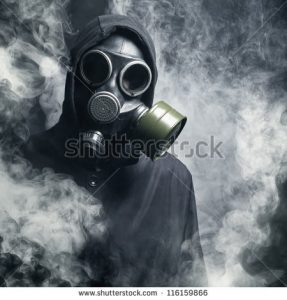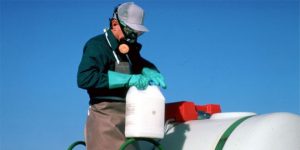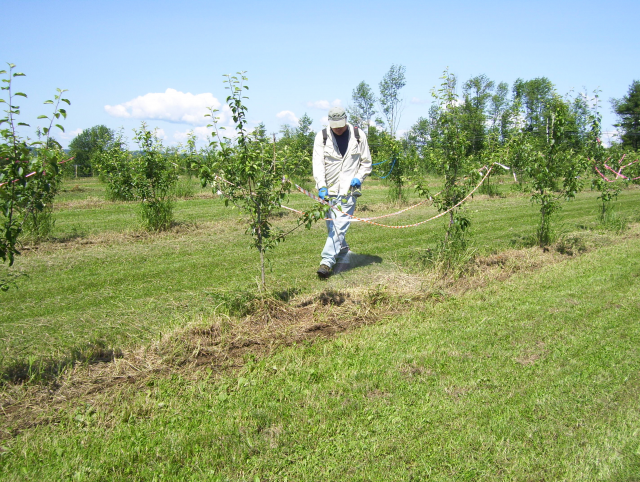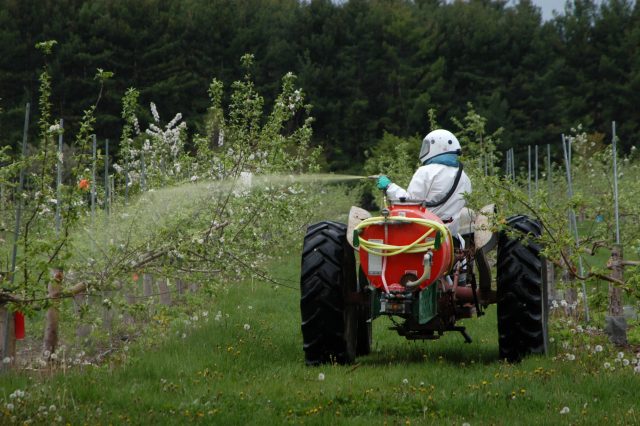Edit: a few clarifying edits were made after initial publication. Also, a second, related essay was posted to call out hypocrisy and lazy thinking among the modern-agriculture advocates.
Recently I had a spat with a colleague over what I thought was her use of negative imagery toward non-organic farmers in a lecture. One thing that really got me going was the use of what I call “Monsanto Gas Mask Man” in a slide that discussed some of the dangers of pesticides.

1. http://fitlife.tv/breaking-news-popular-monsanto-pesticide-found-to-cause-cancer_original/

2. http://www.healingtalks.com/sustainability/environment/pesticides-dectected-in-7-out-of-10-fruits-vegetables
We’ve talked since, I aired my concerns and she hers, and we are in a good place. I respect her. But those images are everywhere in the online and other discussions around modern agriculture. I’ve stewed a bit over my reaction to them, and have come up with a few points of discussion.
I’ll frame this first by mentioning my farming background. I was raised on a small, conventional Vermont dairy farm in the 1980s and 90s. We weren’t organic (no one was doing organic dairy then), but we were a largely pasture-based farm that struggled to compete in the modern commodity landscape. Dad did his best to ‘modernize’- we used synthetic fertilizers; employed improved herd genetics to get our production per cow up; grew corn occasionally using herbicides; and even docked tails in the later years to reduce somatic cells counts in our milk. We were a 45-50 head, tie stall dairy that struggled in the greater economy, yet we held on when many of our neighbors went out of business, and my folks sold the cows at the turn of the millennium after Dad had been working a full-time job off the farm for about five years (Mom always did, or we wouldn’t have eaten) so that he could pay himself to farm. I know the blood, sweat, and literal tears that farmers put into their work, to feed people. And while there are certainly impacts from many agricultural practices on the environment and rural economies, I have never known a farmer, even the few jerks I know in the business, who wants to hurt people.
Since leaving my home farm, I have worked in the industry as a fruit grower and more so as a researcher and instructor. The majority of my current work is with non-organic apple and grape growers, who use agrichemicals as a regular part of their work. The recent discussion over GMO and other farming production methods in the popular media has been largely and carefully directed by activists to paint ‘conventional’ agriculture in an extremely negative light. The rhetoric around non-organic agriculture has been directed using intentionally provocative terms and images, in order to sway public opinion based on fear and emotion rather than science and reason (Clancy and Clancy 2016, Kangmennaang et al. 2016).
The “Monsanto Gas Mask Man” plays into that imagery. Such an image suggests a soldier in a war- the gas masks evoke direct wartime imagery; and the hazmat suits, especially the super-thick nitrile gloves, suggest an outer space-like hostile environment. Faces are obscured, like Storm Troopers. Notice how the company logo is prominent in each well-staged picture. Such imagery places farmers, who are really only trying to make a living, often to sustain a multi-generational family farm in tough times and to produce food for all of us, as disposable pawns at the hands of a corporate general.
I have several problems with the use of such imagery, but I don’t knock my colleague for using it. She has not worked in a pesticide-intensive crop, and therefore does not readily have farm pictures available to use in a lecture. A google image search for ‘pesticide exposure’ brings up a whole host of scary images. However, there are a number of inaccuracies in the photos posted above.
For one, I have seen and worn much personal protective equipment (PPE) used to protect the applicator during spraying, and I have never seen a farmer use the single-canister gas mask-style respirator seen in the photos. I don’t doubt they exist and are labeled for use in applying pesticides, they aren’t commonly used on farms. But where are they commonly seen? In military, survivalist, and other wartime situations. There are some really creepy images out there, and they are often watermarked as stock images, e.g. carefully crafted images for use in developing marketing and other persuasive (activist) campaigns:

3. https://www.shutterstock.com/image-photo/man-gas-mask-smoke-black-background-115621654
Most growers I know, when required to wear a respirator, choose a half-mask type, similar to ones used by painters:

4. http://npic.orst.edu/images/minworkbnr.jpg
Of course, the specific pesticide label legally dictates the amount of PPE to wear when mixing or applying in order to protect the handler from carefully measured and known hazards. I’ll cover the materials shown in the original images in a minute, but for now, lets’ consider glyphosate, highlighted in the imagery by its original brand name Roundup, and almost always identified by its original manufacturer, Monsanto:

5. http://www.wellthychoices.net/wp-content/uploads/2013/02/Roundup-causes-genetic-damage.jpg
Much has been written about the dangers of glyphosate and various papers and studies that claim to support its toxicity- we can discuss that later. However, considerable, long-term evaluation of the research ad safety data indicate that glyphosate is, for a pesticide, relatively safe (Williams et al. 2000, Roos et al. 2005, Mink et al. 2011, Mink et al. 2012, Székács and Darvas 2012, Williams et al. 2012, Kier and Kirkland 2013). Because of that, the PPE required for its application includes “long-sleeved shirt and long pants, shoes plus socks.” That’s it:

6. Worker applying glyphosate-based herbicide and wearing appropriate personal protective equipment. TB photo.
But in popular and activist press, a very different image is used:

7. http://www.npr.org/sections/thesalt/2017/03/15/520250505/emails-reveal-monsantos-tactics-to-defend-glyphosate-against-cancer-fears
And we’re back to the scary imagery…in an NPR article nonetheless!
As for the specific images referenced at the beginning, let’s consider the materials in the photos. I will never say that every pesticide is safe, in fact I teach pesticide safety as part of my job, I am also familiar with the safety and registration process the EPA uses to review and license pesticides. A typical pesticide requires around $10-20 million for registration, and much of that is used in required short- and long-term testing for acute and chronic toxicity, carcinogenicity, mutagenetic, and environmental effects. The results of that testing determine allowed use restrictions, including rates, timing, and other safety considerations; the requirements for those tests would take several hundreds of pages to print. My point is that pesticides are indeed inherently harmful, and there is a good safety program in-place to regulate their use, which includes the use of appropriate PPE, and use restrictions that limit rates, timing, and other application criteria. (Why even use them at all? To reduce the 25-80% of crop losses attributable to pests that would decimate our food supply (Oerke 2006)).
So, consider those original images. The first material highlighted, Lasso, is an herbicide containing the active ingredient alachlor which is indeed pretty nasty, as it is a pretty powerful carcinogen. How much alachlor is used in modern agriculture in the U.S.? Extremely little, because it has been replaced by the dramatically safer glyphosate, aided by herbicide-tolerance traits in genetically engineered field crops. So the demon GMOs have indeed helped to push out a pretty toxic material, which goes against the scary spray guy analogy. (Ironically, the little bit of alachlor still used is primarily in ‘Non-GMO Project’, corn and soybeans. That Non-GMO Project sure is doing good things, huh?).

8. https://water.usgs.gov/nawqa/pnsp/usage/maps/show_map.php?year=2012&map=ALACHLOR&hilo=L&disp=Alachlor
How about that other material in the Greenpeace photo, “E605 Forte”? That’s an insecticide containing parathion, a highly toxic organophosphate (OP) material whose use was cancelled in the U.S. in 1991, and which is severely limited elsewhere in the world (although I imagine used in the developing world, unfortunately). The whole class of OPs has been reviewed since the adoption of the U.S. Food Quality Protection Act in 1995, and not only has their overall use gone down substantially since then, but the new materials that have been developed in their wake have significantly lower toxicity profiles (Jones et al. 2010).
At the risk of dragging things out, my aversion to this imagery is based on the lies behind it- that farmers are trying to hurt anyone, that our food system is unsafe and riddled with dangerous chemicals, and that organic farmers inherently are above such nastiness. Because here I am, spraying an approved pesticide on my organic apple crop, wearing the appropriate PPE for the job.

9. The author applying sulfur-based pesticides to an organic apple crop. TB photo.
Farming isn’t performed by beautiful elves flitting about their fields of green, nor is it done by ogres and trolls at the hands evil corporate overlords. It’s done by real people, who bust their butts to feed us (you). Demonizing them (us) via violent imagery and rhetoric is an insult to us all, as farmers, consumers, and citizens, and that’s why I speak out against it. With no disrespect to my dear friend who started me on this rant, I suggest we all step back and think about how we portray them, especially those of us who know better.
-TB
Clancy, K. A., and B. Clancy. 2016. Growing monstrous organisms: the construction of anti-GMO visual rhetoric through digital media. Critical Studies in Media Communication 33: 279-292.
Jones, V. P., S. A. Steffan, L. A. Hull, J. F. Brunner, and D. J. Biddinger. 2010. Effects of the loss of organophosphate pesticides in the US: opportunities and needs to improve IPM programs. Outlooks on Pest Management 21: 161-166.
Kangmennaang, J., L. Osei, F. A. Armah, and I. Luginaah. 2016. Genetically modified organisms and the age of (Un) reason? A critical examination of the rhetoric in the GMO public policy debates in Ghana. Futures 83: 37-49.
Kier, L. D., and D. J. Kirkland. 2013. Review of genotoxicity studies of glyphosate and glyphosate-based formulations. Critical reviews in toxicology 43: 283-315.
Mink, P. J., J. S. Mandel, J. I. Lundin, and B. K. Sceurman. 2011. Epidemiologic studies of glyphosate and non-cancer health outcomes: a review. Regulatory Toxicology and Pharmacology 61: 172-184.
Mink, P. J., J. S. Mandel, B. K. Sceurman, and J. I. Lundin. 2012. Epidemiologic studies of glyphosate and cancer: A review. Regulatory Toxicology and Pharmacology 63: 440-452.
Oerke, E.-C. 2006. Crop losses to pests. The Journal of Agricultural Science 144: 31-43.
Roos, A. J. D., B. Aaron, J. A. Rusiecki, J. A. Hoppin, M. Svec, M. Dosemeci, D. P. Sandler, and M. C. Alavanja. 2005. Cancer Incidence among Glyphosate-Exposed Pesticide Applicators in the Agricultural Health Study. Environmental Health Perspectives 113: 49-54.
Székács, A., and B. Darvas. 2012. Forty years with glyphosate, pp. 247-284. In M. N. A. E.-G. Hassaneen (ed.), Herbicides–properties, synthesis and control of weeds. . InTech Europe, Rijeka, Croatia.
Williams, A. L., R. E. Watson, and J. M. DeSesso. 2012. Developmental and reproductive outcomes in humans and animals after glyphosate exposure: a critical analysis. Journal of Toxicology and Environmental Health, Part B 15: 39-96.
Williams, G. M., R. Kroes, and I. C. Munro. 2000. Safety Evaluation and Risk Assessment of the Herbicide Roundup and Its Active Ingredient, Glyphosate, for Humans. Regulatory Toxicology and Pharmacology 31: 117-165.

Pingback: Agvocates: It’s Your Turn to Stop the Mud Slinging – Food and Farm Discussion Lab
Pingback: Monsanto Gas Mask Man: Activist imagery and its meaning to farmers – Food and Farm Discussion Lab